University: Assessment 1 - Emotional Intelligence Reflection Report
VerifiedAdded on 2023/06/10
|6
|1216
|109
Report
AI Summary
This report presents a reflection on emotional intelligence, focusing on self-awareness and emotional management within a workplace context. The author identifies personal emotional strengths and weaknesses through a SWOT analysis and discusses three instances of experiencing stress or negative emotions at work, detailing the causes and responses to each situation. Triggers for negative emotional states, such as dishonesty and public speaking, are explored, along with strategies for managing these triggers. The report highlights an instance of modeled emotional behavior and proposes actions to enhance emotional intelligence, including taking public speaking classes and improving team-working skills. References to relevant academic sources are included to support the analysis. The student aims to become emotionally stronger and convert negative responses into positive actions to enhance professional relationships and performance.
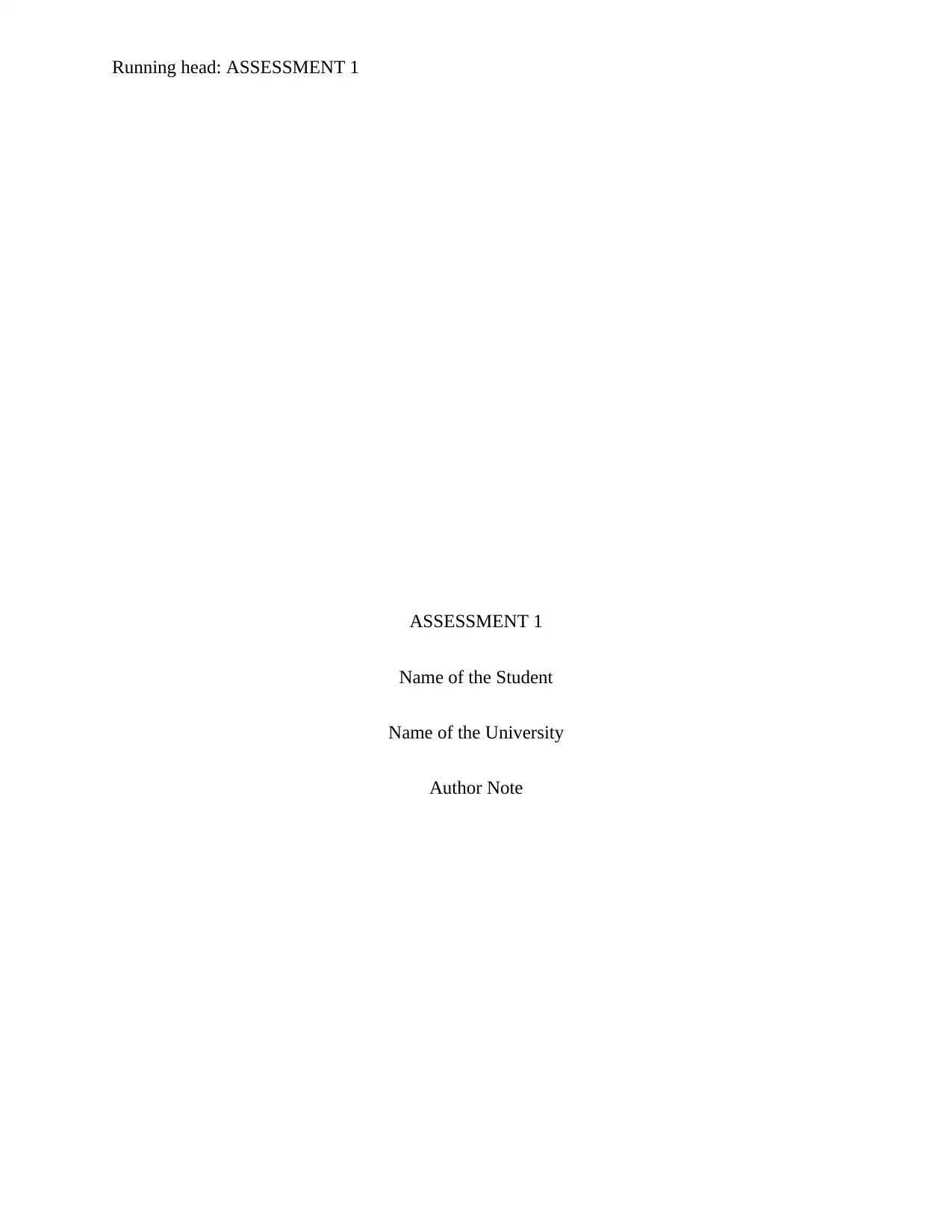
Running head: ASSESSMENT 1
ASSESSMENT 1
Name of the Student
Name of the University
Author Note
ASSESSMENT 1
Name of the Student
Name of the University
Author Note
Paraphrase This Document
Need a fresh take? Get an instant paraphrase of this document with our AI Paraphraser
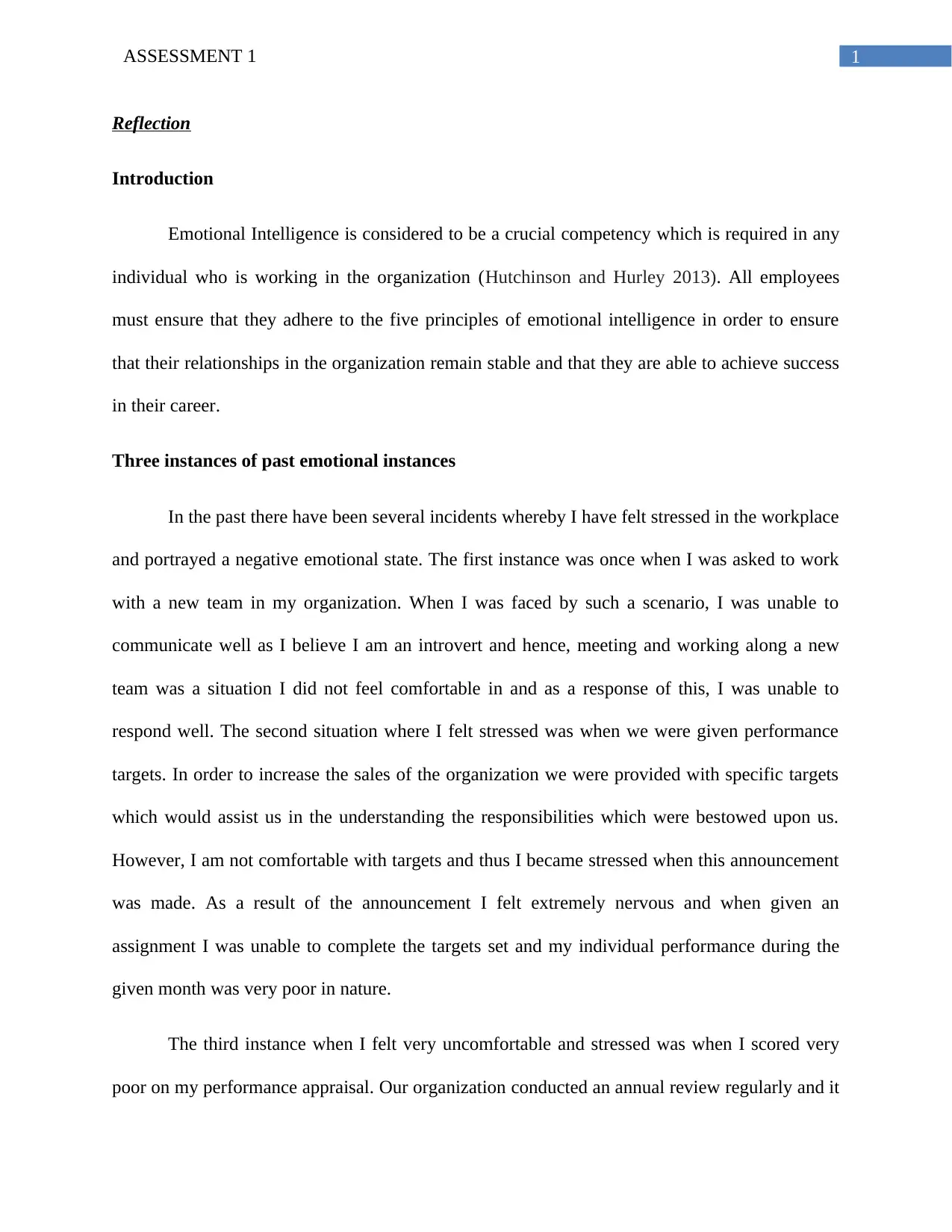
1ASSESSMENT 1
Reflection
Introduction
Emotional Intelligence is considered to be a crucial competency which is required in any
individual who is working in the organization (Hutchinson and Hurley 2013). All employees
must ensure that they adhere to the five principles of emotional intelligence in order to ensure
that their relationships in the organization remain stable and that they are able to achieve success
in their career.
Three instances of past emotional instances
In the past there have been several incidents whereby I have felt stressed in the workplace
and portrayed a negative emotional state. The first instance was once when I was asked to work
with a new team in my organization. When I was faced by such a scenario, I was unable to
communicate well as I believe I am an introvert and hence, meeting and working along a new
team was a situation I did not feel comfortable in and as a response of this, I was unable to
respond well. The second situation where I felt stressed was when we were given performance
targets. In order to increase the sales of the organization we were provided with specific targets
which would assist us in the understanding the responsibilities which were bestowed upon us.
However, I am not comfortable with targets and thus I became stressed when this announcement
was made. As a result of the announcement I felt extremely nervous and when given an
assignment I was unable to complete the targets set and my individual performance during the
given month was very poor in nature.
The third instance when I felt very uncomfortable and stressed was when I scored very
poor on my performance appraisal. Our organization conducted an annual review regularly and it
Reflection
Introduction
Emotional Intelligence is considered to be a crucial competency which is required in any
individual who is working in the organization (Hutchinson and Hurley 2013). All employees
must ensure that they adhere to the five principles of emotional intelligence in order to ensure
that their relationships in the organization remain stable and that they are able to achieve success
in their career.
Three instances of past emotional instances
In the past there have been several incidents whereby I have felt stressed in the workplace
and portrayed a negative emotional state. The first instance was once when I was asked to work
with a new team in my organization. When I was faced by such a scenario, I was unable to
communicate well as I believe I am an introvert and hence, meeting and working along a new
team was a situation I did not feel comfortable in and as a response of this, I was unable to
respond well. The second situation where I felt stressed was when we were given performance
targets. In order to increase the sales of the organization we were provided with specific targets
which would assist us in the understanding the responsibilities which were bestowed upon us.
However, I am not comfortable with targets and thus I became stressed when this announcement
was made. As a result of the announcement I felt extremely nervous and when given an
assignment I was unable to complete the targets set and my individual performance during the
given month was very poor in nature.
The third instance when I felt very uncomfortable and stressed was when I scored very
poor on my performance appraisal. Our organization conducted an annual review regularly and it
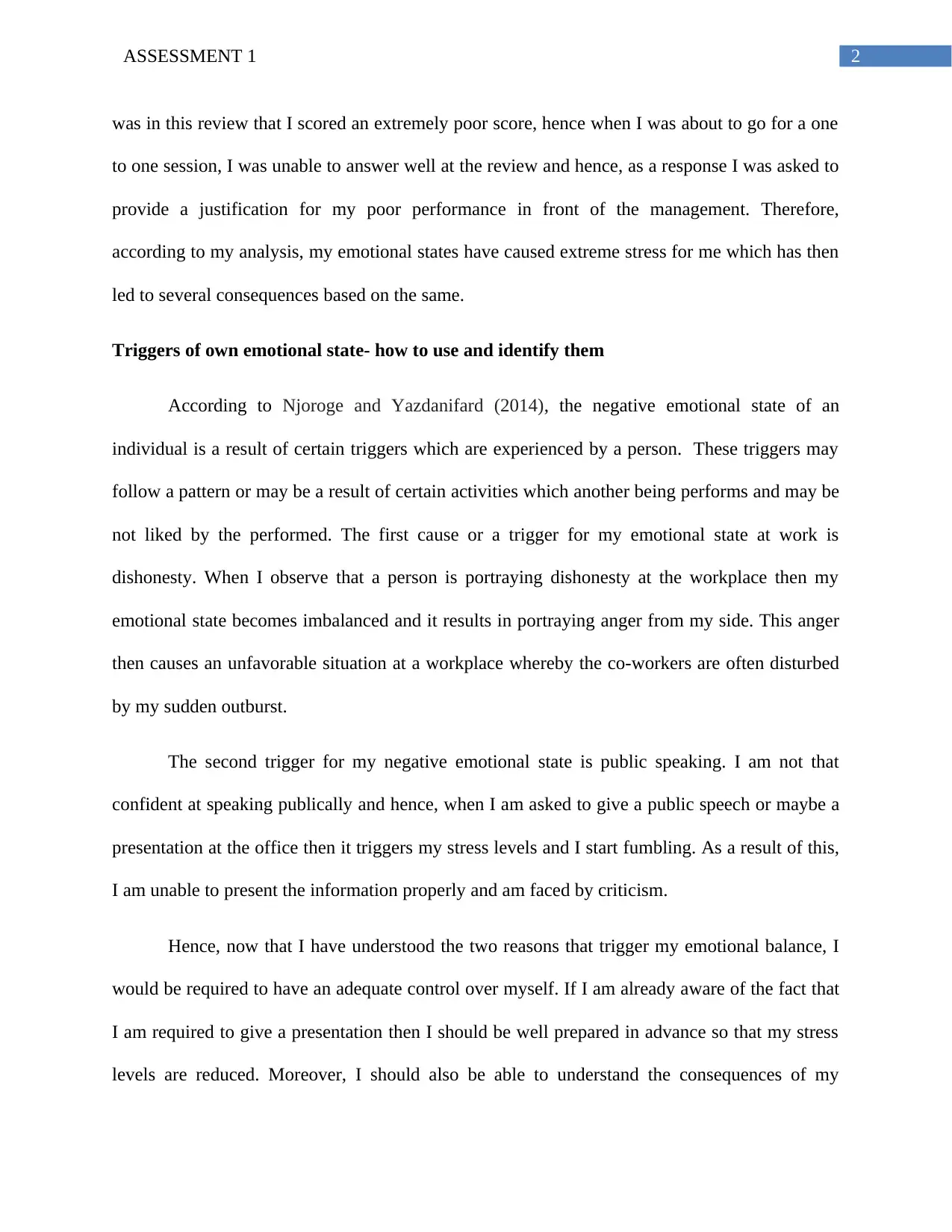
2ASSESSMENT 1
was in this review that I scored an extremely poor score, hence when I was about to go for a one
to one session, I was unable to answer well at the review and hence, as a response I was asked to
provide a justification for my poor performance in front of the management. Therefore,
according to my analysis, my emotional states have caused extreme stress for me which has then
led to several consequences based on the same.
Triggers of own emotional state- how to use and identify them
According to Njoroge and Yazdanifard (2014), the negative emotional state of an
individual is a result of certain triggers which are experienced by a person. These triggers may
follow a pattern or may be a result of certain activities which another being performs and may be
not liked by the performed. The first cause or a trigger for my emotional state at work is
dishonesty. When I observe that a person is portraying dishonesty at the workplace then my
emotional state becomes imbalanced and it results in portraying anger from my side. This anger
then causes an unfavorable situation at a workplace whereby the co-workers are often disturbed
by my sudden outburst.
The second trigger for my negative emotional state is public speaking. I am not that
confident at speaking publically and hence, when I am asked to give a public speech or maybe a
presentation at the office then it triggers my stress levels and I start fumbling. As a result of this,
I am unable to present the information properly and am faced by criticism.
Hence, now that I have understood the two reasons that trigger my emotional balance, I
would be required to have an adequate control over myself. If I am already aware of the fact that
I am required to give a presentation then I should be well prepared in advance so that my stress
levels are reduced. Moreover, I should also be able to understand the consequences of my
was in this review that I scored an extremely poor score, hence when I was about to go for a one
to one session, I was unable to answer well at the review and hence, as a response I was asked to
provide a justification for my poor performance in front of the management. Therefore,
according to my analysis, my emotional states have caused extreme stress for me which has then
led to several consequences based on the same.
Triggers of own emotional state- how to use and identify them
According to Njoroge and Yazdanifard (2014), the negative emotional state of an
individual is a result of certain triggers which are experienced by a person. These triggers may
follow a pattern or may be a result of certain activities which another being performs and may be
not liked by the performed. The first cause or a trigger for my emotional state at work is
dishonesty. When I observe that a person is portraying dishonesty at the workplace then my
emotional state becomes imbalanced and it results in portraying anger from my side. This anger
then causes an unfavorable situation at a workplace whereby the co-workers are often disturbed
by my sudden outburst.
The second trigger for my negative emotional state is public speaking. I am not that
confident at speaking publically and hence, when I am asked to give a public speech or maybe a
presentation at the office then it triggers my stress levels and I start fumbling. As a result of this,
I am unable to present the information properly and am faced by criticism.
Hence, now that I have understood the two reasons that trigger my emotional balance, I
would be required to have an adequate control over myself. If I am already aware of the fact that
I am required to give a presentation then I should be well prepared in advance so that my stress
levels are reduced. Moreover, I should also be able to understand the consequences of my
⊘ This is a preview!⊘
Do you want full access?
Subscribe today to unlock all pages.

Trusted by 1+ million students worldwide
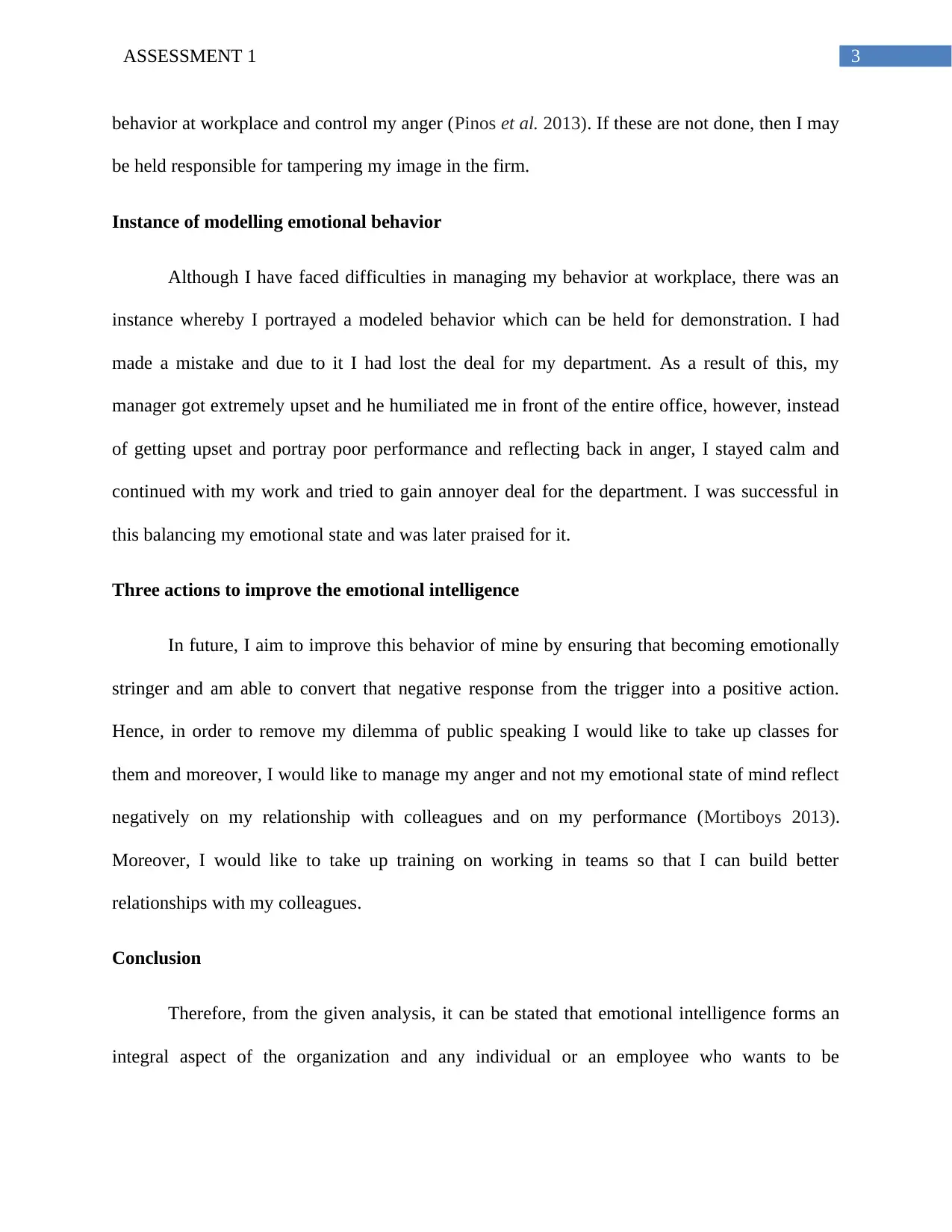
3ASSESSMENT 1
behavior at workplace and control my anger (Pinos et al. 2013). If these are not done, then I may
be held responsible for tampering my image in the firm.
Instance of modelling emotional behavior
Although I have faced difficulties in managing my behavior at workplace, there was an
instance whereby I portrayed a modeled behavior which can be held for demonstration. I had
made a mistake and due to it I had lost the deal for my department. As a result of this, my
manager got extremely upset and he humiliated me in front of the entire office, however, instead
of getting upset and portray poor performance and reflecting back in anger, I stayed calm and
continued with my work and tried to gain annoyer deal for the department. I was successful in
this balancing my emotional state and was later praised for it.
Three actions to improve the emotional intelligence
In future, I aim to improve this behavior of mine by ensuring that becoming emotionally
stringer and am able to convert that negative response from the trigger into a positive action.
Hence, in order to remove my dilemma of public speaking I would like to take up classes for
them and moreover, I would like to manage my anger and not my emotional state of mind reflect
negatively on my relationship with colleagues and on my performance (Mortiboys 2013).
Moreover, I would like to take up training on working in teams so that I can build better
relationships with my colleagues.
Conclusion
Therefore, from the given analysis, it can be stated that emotional intelligence forms an
integral aspect of the organization and any individual or an employee who wants to be
behavior at workplace and control my anger (Pinos et al. 2013). If these are not done, then I may
be held responsible for tampering my image in the firm.
Instance of modelling emotional behavior
Although I have faced difficulties in managing my behavior at workplace, there was an
instance whereby I portrayed a modeled behavior which can be held for demonstration. I had
made a mistake and due to it I had lost the deal for my department. As a result of this, my
manager got extremely upset and he humiliated me in front of the entire office, however, instead
of getting upset and portray poor performance and reflecting back in anger, I stayed calm and
continued with my work and tried to gain annoyer deal for the department. I was successful in
this balancing my emotional state and was later praised for it.
Three actions to improve the emotional intelligence
In future, I aim to improve this behavior of mine by ensuring that becoming emotionally
stringer and am able to convert that negative response from the trigger into a positive action.
Hence, in order to remove my dilemma of public speaking I would like to take up classes for
them and moreover, I would like to manage my anger and not my emotional state of mind reflect
negatively on my relationship with colleagues and on my performance (Mortiboys 2013).
Moreover, I would like to take up training on working in teams so that I can build better
relationships with my colleagues.
Conclusion
Therefore, from the given analysis, it can be stated that emotional intelligence forms an
integral aspect of the organization and any individual or an employee who wants to be
Paraphrase This Document
Need a fresh take? Get an instant paraphrase of this document with our AI Paraphraser
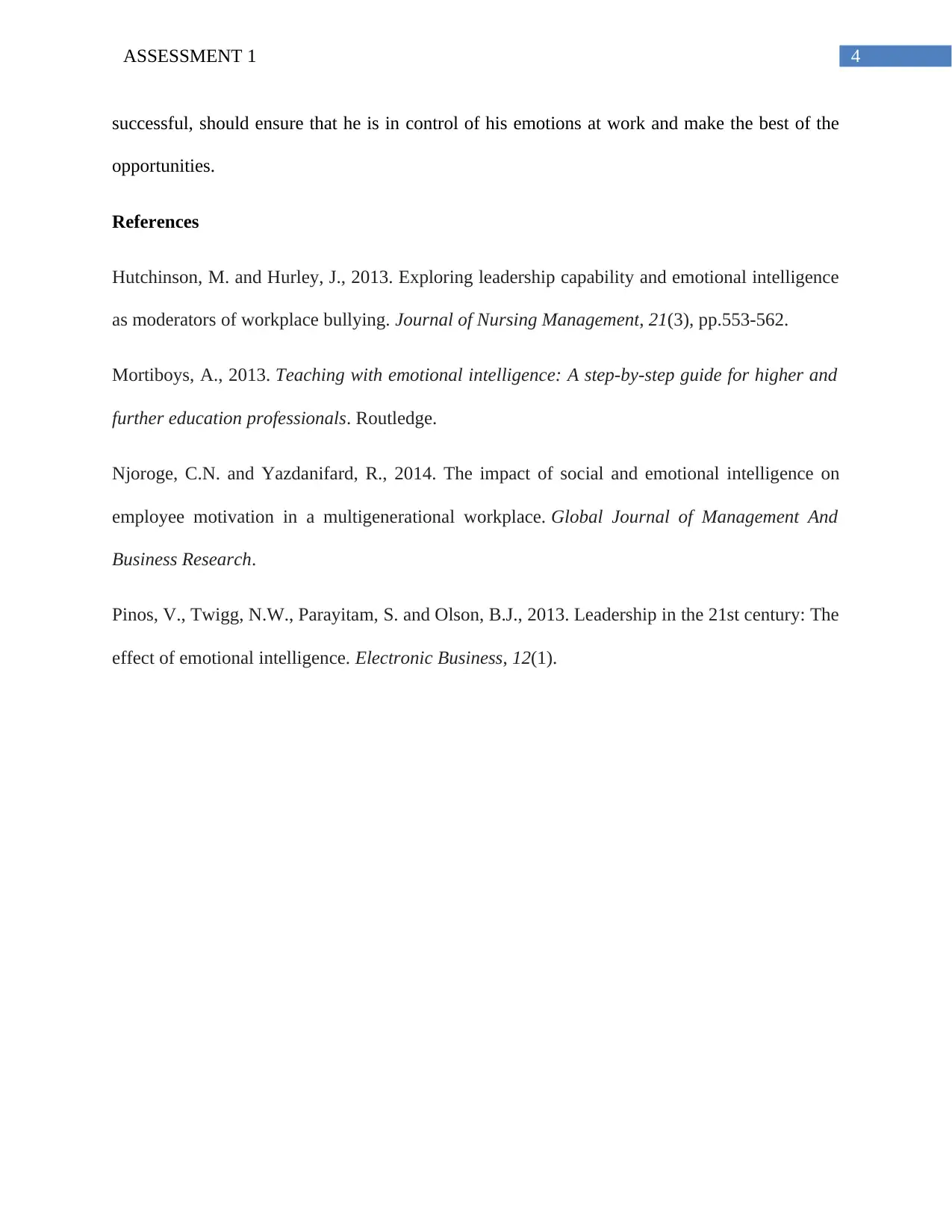
4ASSESSMENT 1
successful, should ensure that he is in control of his emotions at work and make the best of the
opportunities.
References
Hutchinson, M. and Hurley, J., 2013. Exploring leadership capability and emotional intelligence
as moderators of workplace bullying. Journal of Nursing Management, 21(3), pp.553-562.
Mortiboys, A., 2013. Teaching with emotional intelligence: A step-by-step guide for higher and
further education professionals. Routledge.
Njoroge, C.N. and Yazdanifard, R., 2014. The impact of social and emotional intelligence on
employee motivation in a multigenerational workplace. Global Journal of Management And
Business Research.
Pinos, V., Twigg, N.W., Parayitam, S. and Olson, B.J., 2013. Leadership in the 21st century: The
effect of emotional intelligence. Electronic Business, 12(1).
successful, should ensure that he is in control of his emotions at work and make the best of the
opportunities.
References
Hutchinson, M. and Hurley, J., 2013. Exploring leadership capability and emotional intelligence
as moderators of workplace bullying. Journal of Nursing Management, 21(3), pp.553-562.
Mortiboys, A., 2013. Teaching with emotional intelligence: A step-by-step guide for higher and
further education professionals. Routledge.
Njoroge, C.N. and Yazdanifard, R., 2014. The impact of social and emotional intelligence on
employee motivation in a multigenerational workplace. Global Journal of Management And
Business Research.
Pinos, V., Twigg, N.W., Parayitam, S. and Olson, B.J., 2013. Leadership in the 21st century: The
effect of emotional intelligence. Electronic Business, 12(1).
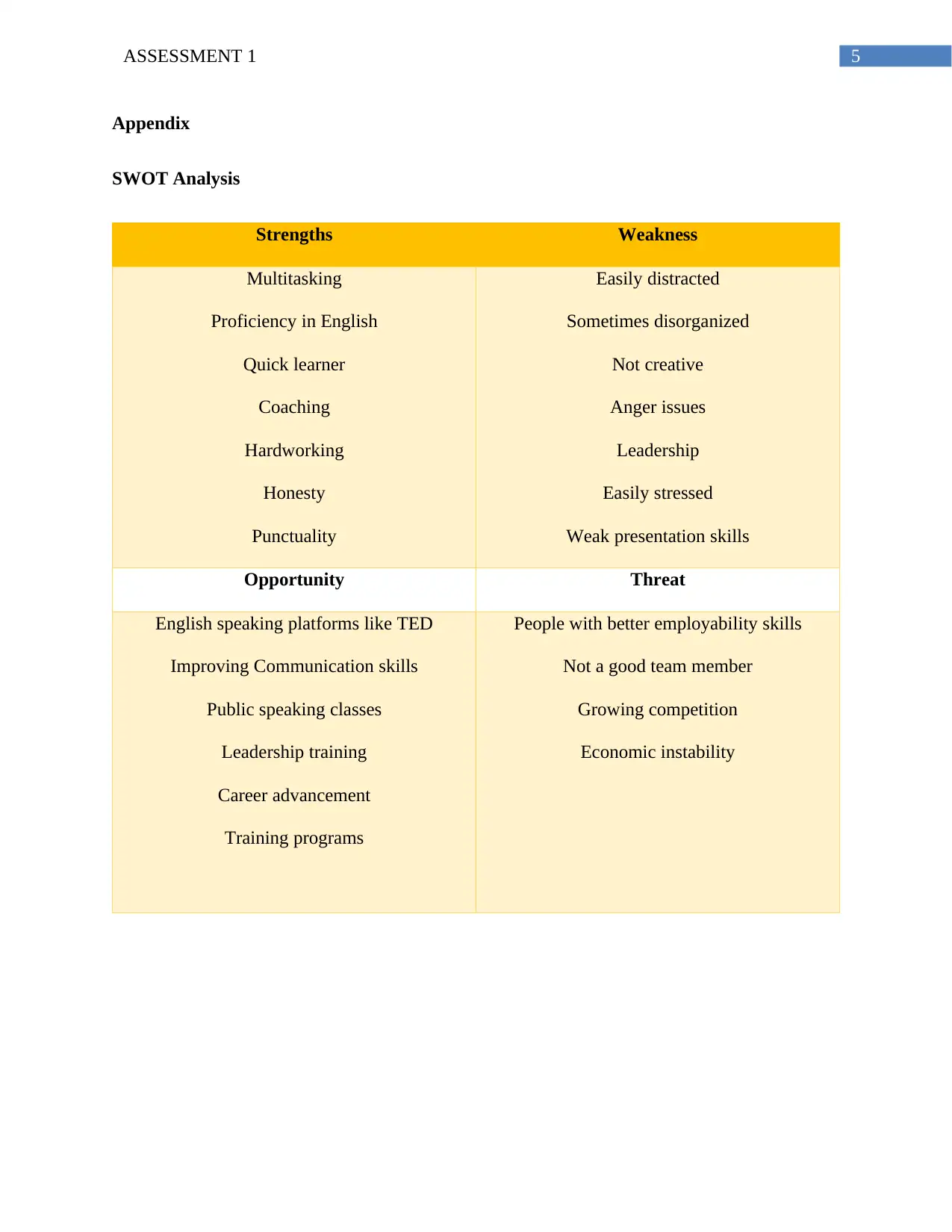
5ASSESSMENT 1
Appendix
SWOT Analysis
Strengths Weakness
Multitasking
Proficiency in English
Quick learner
Coaching
Hardworking
Honesty
Punctuality
Easily distracted
Sometimes disorganized
Not creative
Anger issues
Leadership
Easily stressed
Weak presentation skills
Opportunity Threat
English speaking platforms like TED
Improving Communication skills
Public speaking classes
Leadership training
Career advancement
Training programs
People with better employability skills
Not a good team member
Growing competition
Economic instability
Appendix
SWOT Analysis
Strengths Weakness
Multitasking
Proficiency in English
Quick learner
Coaching
Hardworking
Honesty
Punctuality
Easily distracted
Sometimes disorganized
Not creative
Anger issues
Leadership
Easily stressed
Weak presentation skills
Opportunity Threat
English speaking platforms like TED
Improving Communication skills
Public speaking classes
Leadership training
Career advancement
Training programs
People with better employability skills
Not a good team member
Growing competition
Economic instability
⊘ This is a preview!⊘
Do you want full access?
Subscribe today to unlock all pages.

Trusted by 1+ million students worldwide
1 out of 6
Related Documents
Your All-in-One AI-Powered Toolkit for Academic Success.
+13062052269
info@desklib.com
Available 24*7 on WhatsApp / Email
![[object Object]](/_next/static/media/star-bottom.7253800d.svg)
Unlock your academic potential
Copyright © 2020–2025 A2Z Services. All Rights Reserved. Developed and managed by ZUCOL.





